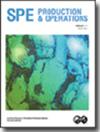Quantitative Hydraulic-Fracture-Geometry Characterization with Low-Frequency Distributed-Acoustic-Sensing Strain Data: Fracture-Height Sensitivity and Field Applications
IF 1.3
4区 工程技术
Q2 ENGINEERING, PETROLEUM
引用次数: 6
Abstract
Low-frequency distributed acoustic sensing (LF-DAS) has been used for hydraulic fracture monitoring and characterization. Large amounts of DAS data have been acquired across different formations. The low-frequency components of DAS data are highly sensitive to mechanical strain changes. Forward geomechanical modeling has been the focus of current research efforts to better understand LF-DAS signals. Moreover, LF-DAS provides the opportunity to quantify fracture geometry. Recently, Liu et al. (2021a, 2021b) proposed an inversion algorithm to estimate hydraulic-fracture width using LF-DAS data measured during multifracture propagation. The LF-DAS strain data are linked to the fracture widths through a forward model developed based on the displacement discontinuity method. In this study, we first investigated the impacts of fracture height on the inversion results through a numerical case with a four-cluster completion design. Then we discussed how to estimate the fracture height based on the inversion results. Finally, we applied the inversion algorithm to two field examples. The inverted widths are not sensitive to the fracture height. In the synthetic case, the maximum relative error is less than 10% even when the fracture height is two times the true value. After obtaining the fracture width, the fracture height can be estimated by matching the true strain data under various heights with a strong smooth weight. The error between the calculated strain and true strain decreases as the height approaches the true value. In the two field examples, the temporal evolutions of the width summation of all fractures and the width of each fracture show consistent behaviors with the field LF-DAS measurements. The calculated strain data from the forward model match well with the field LF-DAS strain data. The results demonstrate the robustness and accuracy of the proposed inversion algorithm.低频分布式声敏应变数据的定量水力裂缝几何特征:裂缝高度敏感性及其现场应用
低频分布式声学传感(LF-DAS)已被用于水力压裂监测和表征。已经在不同的地层中获取了大量的DAS数据。DAS数据的低频分量对机械应变变化高度敏感。正向地质力学建模一直是当前研究工作的重点,以更好地理解LF-DAS信号。此外,LF-DAS提供了量化裂缝几何形状的机会。最近,刘等人(2021a,2021b)提出了一种反演算法,利用多重裂缝传播过程中测量的LF-DAS数据来估计水力裂缝宽度。通过基于位移不连续性方法开发的正演模型,将LF-DAS应变数据与裂缝宽度联系起来。在本研究中,我们首先通过四簇完井设计的数值例子研究了裂缝高度对反演结果的影响。然后,我们讨论了如何根据反演结果估计裂缝高度。最后,我们将反演算法应用于两个现场实例。反向宽度对裂缝高度不敏感。在综合情况下,即使裂缝高度是真实值的两倍,最大相对误差也小于10%。在获得裂缝宽度后,可以通过将不同高度下的真实应变数据与强光滑权重相匹配来估计裂缝高度。计算应变和真实应变之间的误差随着高度接近真实值而减小。在两个现场示例中,所有裂缝的宽度总和和每个裂缝的宽度的时间演变显示出与现场LF-DAS测量一致的行为。正演模型计算的应变数据与现场LF-DAS应变数据吻合良好。结果证明了所提出的反演算法的稳健性和准确性。
本文章由计算机程序翻译,如有差异,请以英文原文为准。
求助全文
约1分钟内获得全文
求助全文
来源期刊

Spe Production & Operations
工程技术-工程:石油
CiteScore
3.70
自引率
8.30%
发文量
54
审稿时长
3 months
期刊介绍:
SPE Production & Operations includes papers on production operations, artificial lift, downhole equipment, formation damage control, multiphase flow, workovers, stimulation, facility design and operations, water treatment, project management, construction methods and equipment, and related PFC systems and emerging technologies.
 求助内容:
求助内容: 应助结果提醒方式:
应助结果提醒方式:


